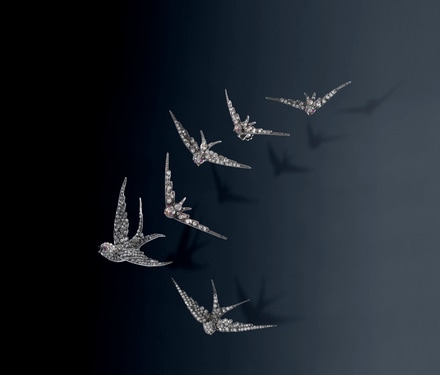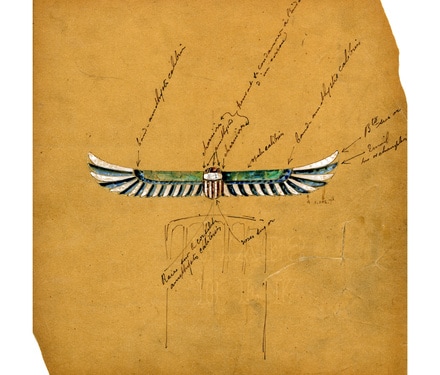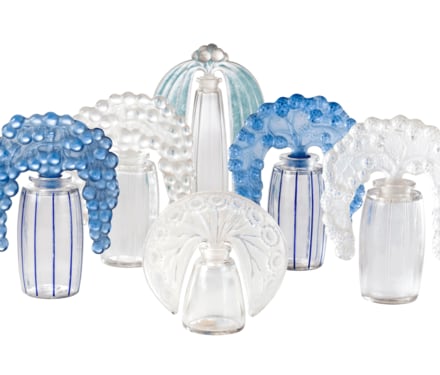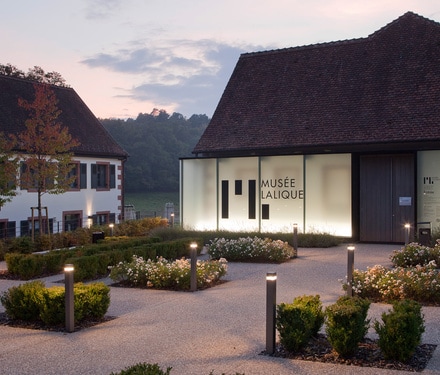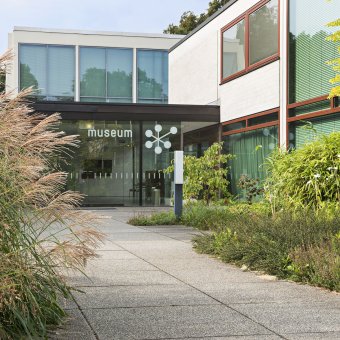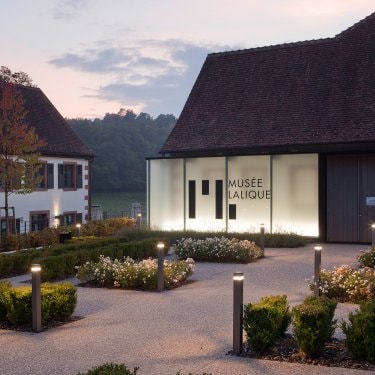
Located in the Vosges, this museum highlights the glass work of René Lalique through 650 objects from the 1890s to today. Plus some beautiful jewels that alone are worth the trip.
Located in the Vosges, this museum highlights the glass work of René Lalique through 650 objects from the 1890s to today. Plus some beautiful jewels that alone are worth the trip.
"بانسي"، عقد ملاصق للعنق، ذهب، ماس، مينا، لؤلؤ – قرابة 1902-1904 من مجموعة متحف لاليك. بمساهمة من شاي باندمان ورونالد أوي
© استديو ي. لانغلواOpened in 2011, this public museum dedicated to the master of Art Nouveau is located in a region with a rich glass-making history. It was in the village of Wingen-sur-Moder that the versatile artist established his manufacturing workshop in 1921. While the collection is organized chronologically and focuses on his glass works, there are also around sixty magnificent pieces of jewelry.
"نايت باترفلايز"، زينة للصدر، ذهب، ماس بالقطع البرّاق، مينا وزجاج – قرابة 1906-1907
مجموعة متحف لاليك. بمساهمة من شاي باندمان ورونالد أوي
The jewelry, gathered in the first room, serves as a great introduction and helps to understand why René Lalique was "the inventor of modern jewelry". In the late 19th century, this jeweler revolutionized the codes of traditional jewelry by abandoning precious stones in favor of the expressive power of ivory, horn, and especially translucent enamel, his favorite material. Everything was new, including his inspirations: women hybridized with butterflies, fleeting sensations observed in nature, the flora from seed to withering, as well as more unsettling fauna such as wasps, bats, etc. René Lalique established himself as THE jeweler of Art Nouveau.
زينة صدر مكوّنة من خمسة سنونوات، ذهب، فضة، ماس، ياقوت – قرابة 1866-1867
من مجموعة متحف لاليك. بمساهمة من شاي باندمان ورونالد أوي
The museum houses iconic pieces that are referenced in books and international exhibitions, such as the corsage front made up of five swallows (one of Lalique's first pieces of jewelry). It is the only museum to boast a remarkable series of dog collars formed by spectacular enameled plates. And then there are the night butterfly brooches, glorious creations in blue-grey glass, or the "The Faun's Kiss" bracelet in bright green glass. "René Lalique had a predilection for this material which enabled him to work in volume to obtain mini sculptures and fantastic plays of light. The effect is incomparable: the figures come out of the frame and come to life," explains Véronique Brumm Schaich, the museum's director.
Drawing for an Egyptian pectoral "Beetle with open wings" - Circa 1898? - Indian ink, watercolor. Lalique Museum Collection.
...to examine the twenty original preparatory studies and drawings, which are renewed every 6 months. Remember that René Lalique excelled in technique (he filed many patents) as well as in illustration: he started by drawing models for all the great jewelers such as Chaumet or Boucheron. Enlarged projections of his studies make it possible to make out, among the pencil strokes, instructions intended for the workshop concerning the cutting and setting of a stone, the color of the enamel, etc.
قوارير "تيارا" من الزجاج المنفخ في قوالب
© كارين فابيThis museum enables the jewelry pieces to be placed in the context of an oeuvre that was subsequently entirely devoted to glass. In 1912, he stopped creating necklaces, bracelets, and combs. The collection of perfume bottles, showcasing his technical virtuosity and eternal inspirations, is impressive. Don't miss the tiare bottle caps, an allusion to his first job! That is followed by a profusion of vases, tableware, cups, and Art Deco lighting fixtures. He even created sacred art. "The inventor of modern jewelry" became a "poet of glass." In 1945, the material became scarce; René Lalique passed away, and his son Marc took the path of crystal, the focus of the final room, to prepare for its entry into the 21st century.
متحف لاليك
© دافيد دوسالوThis museum, located in Wingen-sur-Moder, in the heart of the Northern Vosges – a region with a rich glassmaking tradition – gives visitors a rich insight into the growing importance of glass in the work of René Lalique. In fact, at the height of his career, he even abandoned jewelry-making altogether.
By Sandrine Merle.
By Sandrine Merle
Part of the "Jewelry Collections of the World" series, in partnership between L'ÉCOLE, School of Jewelry Arts and The French Jewelry Post
By Sandrine Merle
Part of the "Jewelry Collections of the World" series, in partnership between L'ÉCOLE, School of Jewelry Arts and The French Jewelry Post
Specialized in the history of documentary drawing and scientific illustration between the 16th and 17th centuries, expert in the development of genre painting (portrait, still life, flower painting, etc.), and in the development of the art of painting.
Sudanese jewelry designer and interior design engineer


